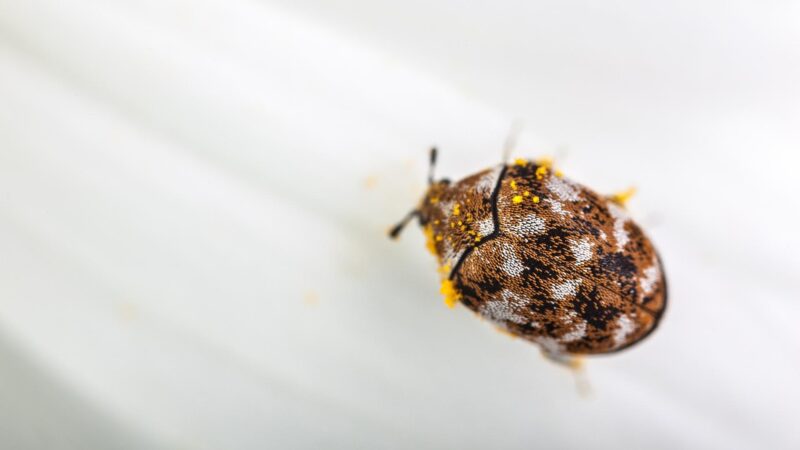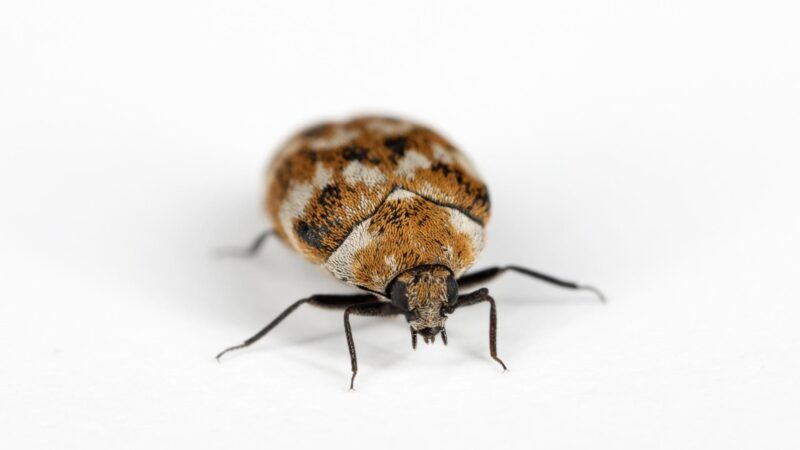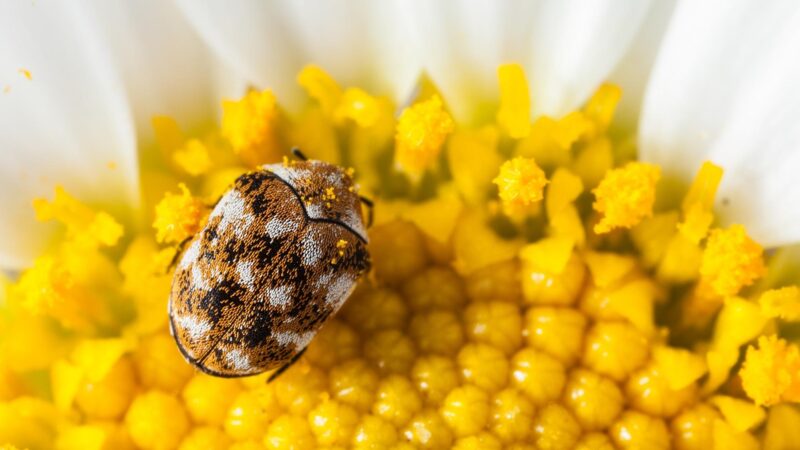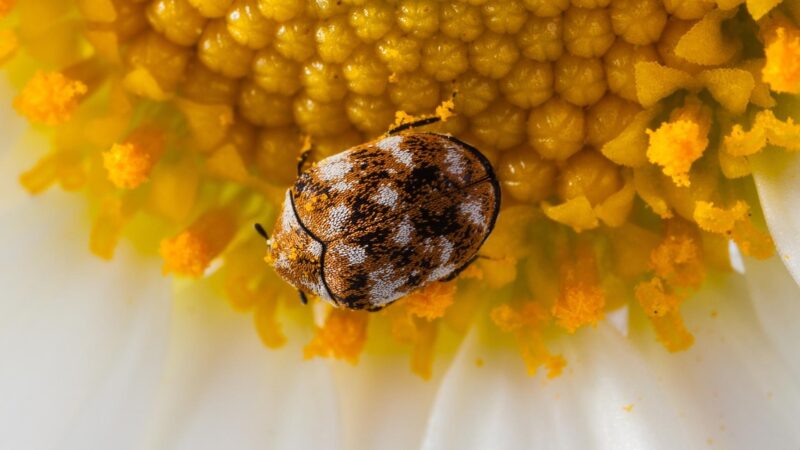Carpet beetles are usually ignored because many people think that these insects only attack carpets. Some people also confused them with clothes moths since they also infest fabric. The truth is that carpet beetles are also pantry pests as some species also feed on seeds and grains. But there’s more about them.
Carpet beetle larvae are very harmful to dry food and belongings. This includes clothes, socks, carpets, leather goods, and preserved specimens such as stuffed animals. They don’t bite or sting, but their mere presence can trigger an allergic reaction, especially in sensitive people.
The three most common carpet beetle species are the black carpet beetle, the furniture carpet beetle, and the varied carpet beetle. Their adults are nuisances and have similar habits, but their larvae are destructive ones. In this article, you will learn the damage they can do and how to get rid of them naturally.
Are Carpet Beetles Bad?

Adult carpet beetles are not necessarily bad insects if they are outdoors. They feed on pollen flowers and are great pollinators. But then, their larvae cause damage to items made from plant and animal fibers. This includes carpets, rugs, clothes, and leather. They don’t eat synthetic fibers but can still damage them.
Meanwhile, larvae of varied carpet beetles (Anthrenus verbasci) also feed on animal horns, leather book bindings, feathers, and animal hair. They also eat keratin-containing objects such as bird nests and stuffed animals. Aside from houses, this carpet beetle species are also usually found in museums.
On the other hand, larvae of the black carpet beetle (Attagenus unicolor) are not so much of pests in fabrics. Instead, they feed more on stored dry food products. This includes cereals, flour, and grains. They are very destructive pests and are bad to be with at home. Not to mention, black carpet beetles also infest warehouses.
Are Carpet Beetles Harmful to People?
Carpet beetles are not harmful to people. Both the adults and larvae don’t bite or sting humans. They also don’t carry infectious diseases. However, their spiny hairs and shed skin can cause allergies in people with sensitive skin and weak health. Their presence can also cause breathing and digestive tract issues.
Among the symptoms of allergic reaction due to direct contact with carpet beetles are a runny nose and red, itchy, and watery eyes, as well as itchy red bumps on the skin. These rashes look like bed bug bites and cause a burning sensation. Fortunately, carpet beetle rashes can easily be treated with anti-itch creams.
Are Carpet Beetles Harmful to Pets?
Carpet beetles are also not harmful to pets. These household pests don’t suck the blood of animals and are not considered external parasites. Although carpet beetles eat animal hair, they are very unlikely to stay long in live animals. But then, dogs and cats with carpet beetles may lead to itchiness and scratching.
How Are Carpet Beetles Harmful to Belongings?

Adult carpet beetles are harmless. But once they have an opportunity, they will fly in window sills and will soon enter homes. Once inside, females will lay very tiny eggs on food sources. Depending on the species, they can lay between 40 and 90 eggs, which usually hatch from 10 to 20 days.
Carpet beetles larvae undergo several molting stages and damage belongings until they reach the pupal stage. Aside from being very small, they are usually found in dark and neglected areas. In most cases, the presence of lots of carpet beetle larvae is only discovered once they have already caused severe damage.
Do Carpet Beetles Live In Beds?
Carpet beetles don’t live in beds. Adults are usually outdoors and prefer flying in the gardens and landscapes rather than living indoors. They are attracted to sunlight but are not interested in humans and pets. Outdoors, females will lay eggs on spider webs or bird nests with dead insects as food for their larvae.
Nevertheless, some adults may lay eggs indoors. Their larvae may travel to your bed. Although very rare, they may also be accidentally brought to your bed by your pets. But unlike bed bugs, they won’t stay long, and they don’t hide in mattresses and bed frames. In short, carpet beetle larvae don’t infest beds.
Related: Carpet Beetles in Bed: Do Carpet Beetles Get in Your Bed?
When Should I Worry About Carpet Beetles?

Discovering one or two carpet beetles inside your home is not a major concern. However, you should start to worry once you see a lot of adults flying to your window sills or window panes, especially in the spring. Chances are some of them are now inside your house to overwinter or had laid eggs somewhere.
Carpet beetle larvae can also infest upholstered furniture, which can be pretty expensive. They also destroy piano felts and hammers, especially since both of them have leather. In short, you should worry if you have not checked your stored dry food, seldom-used garments, and other belongings for a long time.
What Does a Carpet Beetle Infestation Look Like?

Like carpet beetles, larvae of clothes moths can damage fabric, carpet, and garments. However, carpet beetle larvae are more adventurous and will crawl from one room to another. Spotting some large holes instead of scattered small holes in your clothes and carpets could be a sign of a carpet beetle infestation.
During a carpet beetle infestation, you will see some larvae shed skins during their molting periods. And because they eat a lot, you can also spot their feces, which are very tiny pellets that look like a grain of sand. Carpet beetle poop is usually brown or black. Adults poop very seldom indoors, and they poop less.
More importantly, a thorough inspection of the items that reveal lots of crawling developing larvae means that carpet beetles have been around for quite some time. Black carpet beetle larvae look like caterpillars, 1/8-3/16 inches (3.2-4.8 mm) long, and have carrot-shaped shiny black bodies covered with stiff hairs.
Varied carpet beetle larvae have teardrop-shaped dark brown bodies, with a narrower front end and broader rear end. Young furniture carpet beetle larvae are white, while the mature ones are chestnut brown or dark red. For severe infestations, you may also see larvae crawling on floors and walls.
How Long Do Carpet Beetles Last?
If ignored, black carpet beetles spend 166-330 days in their larval stage, while varied carpet beetle larvae spend the longest time at 220-630 days. Furniture carpet beetles are the least at 70-94 days only. The pupal stage usually lasts for 10-13 days, while adults live from 2 to 8 weeks only, depending on the species.
Generally speaking, carpet beetles lay eggs only once a year. Aside from being short-lived, adults cannot tolerate very cold temperatures and will die outdoors in the winter. Larvae can survive without food for several weeks and will look for another place if food becomes scarce. Yet, they are very unlikely to go outdoors.
Does Everyone Have Carpet Beetles?

Not everyone has carpet beetles at home. Yet, it is safe to say that almost all homes that are two years old and older have them. Aside from being secretive scavengers, carpet beetle larvae seem to always find a way in entering houses. No wonder they are considered hard-to-control common household pests.
Is It Normal to Have Carpet Beetles?
It is not normal to have carpet beetles unless they are outside. Though seeing one adult or larvae inside your house is not a cause for alarm, you should not be confident. These immature carpet beetles will eat anything that meets their nutritional requirements and can enter your house without getting noticed.
How Do You Find a Carpet Beetle Nest?
Unlike clothes moths, carpet beetles don’t make webs or nests for their eggs. Instead, they deposit eggs on carpets, wool rugs, furniture, dry food storage, and other hidden areas where there is food for developing larvae. But since they don’t have a permanent location, here are some ways to find a carpet beetle nest:
- Search under and around the edges of carpets on the walls and floors, especially those that are seldom cleaned.
- Carefully inspect old wool clothes and other fabric stored in your closet, attic, or basement.
- Check thoroughly underneath the sofa, couch, and other upholstered furniture where there could be scattered pet hair.
- Investigate all dry food packages in your pantry and kitchen cupboards. Check for crawling larvae on the walls, floors, and on top of the cabinet.
- If you have stuffed animals, preserved animal collections, and birds nest, examine them very carefully.
What Home Remedy Kills Carpet Beetles?
When dealing with carpet beetles, professional help is not usually necessary. Fortunately, there are other ways to get rid of them aside from using a vacuum cleaner. Using insecticides indoors poses a health risk and is therefore not recommended. With that, here are simple home remedies to kill carpet beetles:
1. Heat
Place infested belongings at 105°F (40.5°C) or under direct sunlight for at least four hours. This repels and kills all stages of carpet beetles. For non-sensitive items, wash them thoroughly using hot water and soap. Alternatively, use a steam cleaner such as Ivation All in One Household Steam Cleaner .
2. Low-temperature
Low temperatures can also kill carpet beetles. Place infested items inside a plastic bag and store them inside a freezer at -20°F (-28.9°C) for at least 3 days. Loosen the bag a bit so the items inside will not be frozen. If the items are sensitive to cold temperatures, place them at 40-42°F (4.4°C-5.5°C) for a long time to kill the pests.
3. Baking soda
Baking soda is not only a powerful stain remover but also a great tool for killing carpet beetle larvae and eggs on contact. Also known as sodium bicarbonate, baking soda may not be effective for adult carpet beetles. It also has a high PH, which can damage some fabric if huge amounts are applied repeatedly.
4. Boric acid
Boric acid is very toxic to carpet beetle larvae. Since these tiny insects move slowly, you can sprinkle or spray boric acid powder directly on them and let them sit for 2 hours. But like baking soda, it may destroy sensitive fabric, so apply small amounts only. It can also harm humans when inhaled, ingested, or in direct contact.
5. Diatomaceous earth
Diatomaceous earth (DE) is a non-toxic insecticide that kills carpet beetles in contact. This all-natural powder product destroys the insect’s exoskeleton, causing them to dehydrate and dry out. Nonetheless, it only works when dry. Also, make sure that you choose Food-grade DE and not filter-grade.
Is Vacuuming Enough to Get Rid of Carpet Beetles?
Vacuuming is not enough to get rid of carpet beetles, especially if there is already a heavy infestation. Although it can help a lot, some larvae could be hiding in dark areas and places that cannot be reached by a vacuum cleaner. Vacuuming alone is only best in the early stages and if it is being done regularly.
How Do I Permanently Get Rid of Carpet Beetles?
Sad to say, there is no way of getting rid of carpet beetles permanently. These stubborn pests are pretty smart and will always find a way to enter your house. So far, the best way to prevent a carpet beetle infestation is the combination of exclusion and sanitation. Here are some simple things you can do at home:
- Use non-toxic sticky traps such as Catchmaster Double Sided Flying Insect Trap . Place them in window sills and in other areas where adult carpet beetles can stay.
- Vacuum the hidden areas regularly. This includes carpets, closets, under furniture, pantry cupboards, attic, and basement.
- Inspect items such as cut flowers and dry food packages before bringing them inside your house.
- Transfer dry food (and pet food) from the package to properly sealed containers.
- Keep your seldom-used clothes, coats, and blankets in tightly closed boxes. If possible, wash them at least once a month.
- Seal all small gaps and crevices, and fix or replace damaged window screens, especially during fall.
As you probably know by now, getting rid of carpet beetles can be challenging if not attended to at an early stage. And although preventive measures are effective, they should be done consistently. Otherwise, these pesky pests will not hesitate to grab the chance. Note that treating heavy infestations can be very expensive.
List of Sources
Carpet Beetles. (2022). University of Maryland Extension.
Choe, D-H. (2020). Carpet Beetles. Agriculture and Natural Resources, University of California.
Dill, J. F., Kirby, C. A. (2020). Carpet Beetles. The University of Maine.
Green, J. (2019). Carpet Beetles. University of Nebraska–Lincoln.
- How to Get Rid of Copperheads | Practical Guide - August 27, 2023
- How to Get Rid of Corn Snakes | What Makes Them Aggressive? - August 27, 2023
- How to Get Rid of Alligators | Safety Measures and Removal Methods - July 16, 2023
